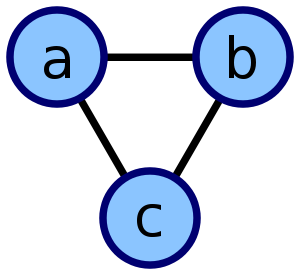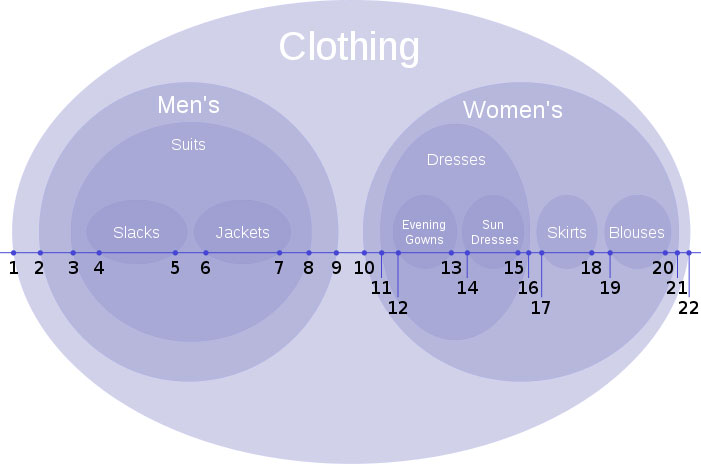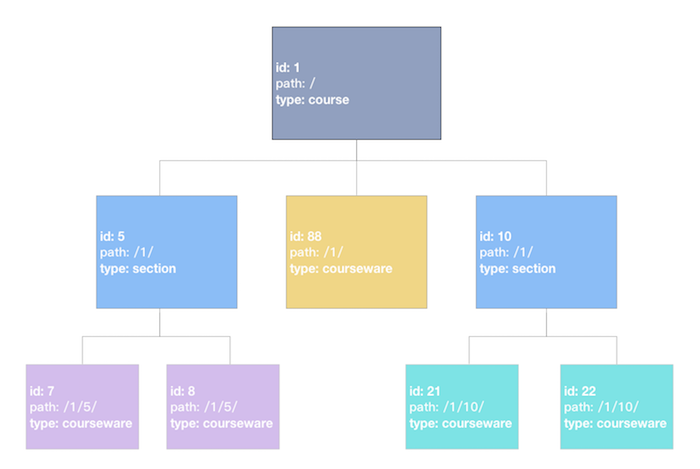Tree Structure 是一种很常见的需求(像分类,目录等),关系数据库中,有几种经典模式:
- Adjacency List Model
- Nested Set Model
- Nested Interval Model
- Materialized Path Model
关于这几种模式的一些通用介绍,参考:
- http://www.dbazine.com/oracle/or-articles/tropashko4/
- http://leopard.in.ua/2013/07/11/storing-trees-in-rdbms/
- https://vadimtropashko.wordpress.com/2008/08/09/one-more-nested-intervals-vs-adjacency-list-comparison/
- https://github.com/ynu/learn-mongodb/tree/master/src/data-model
Ruby Toolbox 中一些对 Tree 的通用库:
1. Adjacency List Model

Use ancestry. It has more powerful query capabilities as it implements the materialized path pattern, as opposed to acts_as_tree that implements adjacency list.
父节点引用的方式(也称父节点引用模式),将树形结构中的每个节点单独存放到一个文档中,并在每个文档中保存节点的父节点引用。 考虑以下数据结构:
| id | type(*optional) | parent_id | depth |
|---|---|---|---|
| 1 | course | 1 | |
| 5 | section | 1 | 1 |
| 7 | courseware | 5 | 2 |
| 8 | courseware | 5 | 2 |
查询出该课程:
1 | SELECT t1.type AS lev1, t2.type as lev2, t3.type as lev3 |
.1 优势
实现起来特别简单,因为只是存储 parent_id,没有多余的算法。
.2 不足
如果想构造一根树,在 DB 查询时,需要太多次循环调用。产生性能问题。
Recursive CTEs
Generating Depth based tree from Hierarchical Data in MySQL (no CTEs)
.3 Rails 实现
Organise ActiveRecord model into a tree structure
- https://github.com/stefankroes/ancestry
- https://github.com/take-five/acts_as_ordered_tree
- https://github.com/amerine/acts_as_tree/tree/master
.4 REF
2. Nested Set Model
.1 Nested Set (前置树)领域模型模式
对应到的 DB Scheme 如下(p_id 非必须,depth 也非必须):
| id | type(*optional) | parent_id | lft | rgt | depth |
|---|---|---|---|---|---|
| 1 | course | 1 | 8 | 0 | |
| 5 | section | 1 | 2 | 7 | 1 |
| 7 | courseware | 5 | 3 | 4 | 2 |
| 8 | courseware | 5 | 5 | 6 | 2 |
如果只是这样看的话,lft, rgt 很难看明白,但换成下面的图,就立即清晰了。

.2 原理
它构建了一个森林(整体),而不是一棵棵的树。
读时,是通过一个条件,将大于根左并且小于根右的全读出即可。
写时,因为整体的原因,在第一颗树上的任意修改,都会反应到后面的树上。
查询该课程
1 | SELECT structs.id |
查询出所有的叶节点:
1 | SELECT id FROM structs WHERE rgt = lft + 1; |
.3 明测
480W 条数据,在最前部加入一个新节点(对 DB 所有记录 lft rft 进行 +2 的方式,全局更新),耗费 97s。😂
可见,这个将会是很严重的性能问题。
不过有种办法可以 fix 这个问题,就是在将森林还原为一棵棵树,每次操作只对树进行,不会影响到其它的树。
这样的话,每颗树的的 lft rgt 0 开始,看起来也清楚点。只是不能跨树进行移动。
.4 REF
- https://en.wikipedia.org/wiki/Nested_set_model
- Managing Hierarchical Data in MySQL (以数据库为视角,讲的很全面)
- 用 Nested Set Model 建立巢狀資料表(繁体文档,很好)
- Adjacency List Model vs Nested Set Model for MySQL hierarchical data?
- http://blog.csdn.net/dreamskyforjava/article/details/23427221
.5 Rails 实现
3. Nested Interval Model
跟 Nested Set 差不多,也是有左右的。
.4 Rails 实现
4. Materialized Path Model

Materialized Path(物化路径)通过在数据中加入它的一个路径,来实现层级关系。
DB Scheme
| id | type(*optional) | path | depth(*optional) |
|---|---|---|---|
| 1 | course | / | 1 |
| 5 | section | /1/ | 2 |
| 7 | courseware | /1/5/ | 3 |
| 8 | courseware | /1/5/ | 3 |
找到所有的 Root
1 | -- find all ROOT |
找到课程1下的所有章节或课件
1 | -- find all sections |
性能
可能在 path 上加上 Index,来提高性能。
https://docs.mongodb.com/manual/tutorial/model-tree-structures-with-materialized-paths/
https://bojanz.wordpress.com/2014/04/25/storing-hierarchical-data-materialized-path/
http://stackoverflow.com/questions/8835178/acts-as-tree-vs-ancestry-gem-for-tree-menu
http://stackoverflow.com/questions/2797720/sorting-tree-with-a-materialized-path/
